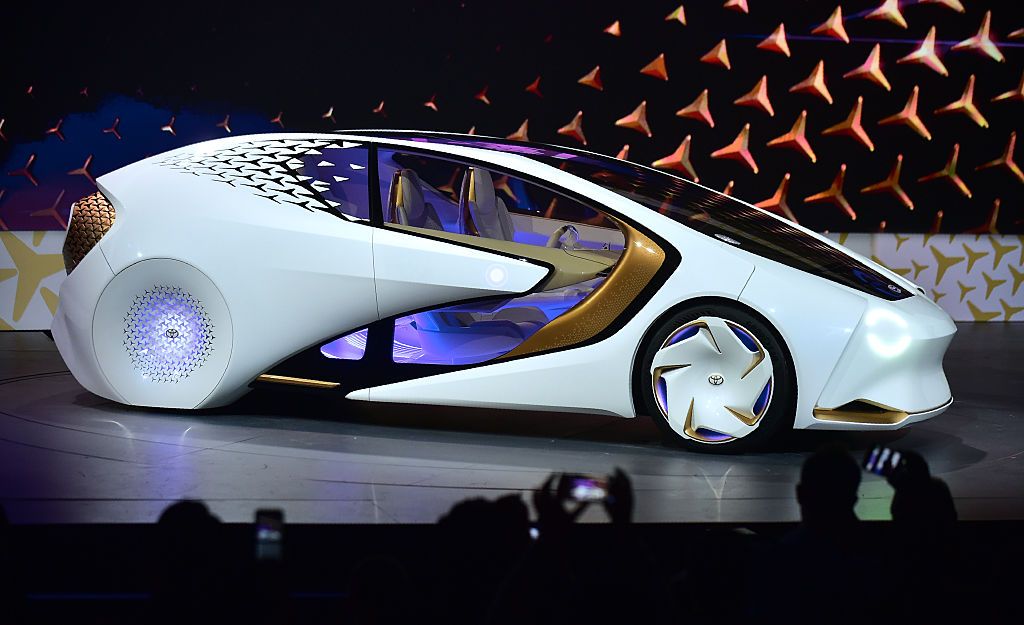A mid-1950s concept car that was neither a fancied-up production model nor a jazzy dream car was the 1954 Mercury Monterey XM-800. It could have been a production car for the 1957 model year, and would have been a very attractive one even with the minor adjustments needed to make it practical and street-legal. Alas, that didn't happen, and by 1958 cars in Ford's stable joined in the styling madness that infected the American automobile industry in those times.
For some background on the Monterey XM-800 and its fate, go here and, especially, here.
Even though it did not become a production design, the XM-800 lent a few styling features to future Ford Motor Company models. These are shown below.
High angle photo of the XM-800. Basically, the design is a clean, archetypical example of mid-1950s American styling. Significant details include the panoramic windshield, the thin roofline, low hood, and the very long fender line where the endpoints are the extremes of the body (not counting bumpers).
Front three-quarter from slightly below eye-level. The air scoop on the hood might actually be functional (I can't be sure), but regardless, it adds interest.
A 1957 Mercury Montclair. Its grille design has a bit of the XM-800's flavor.
The 1961 Mercury grille is even closer. But these are the only models years halfway close to 1954 where the theme was used.
The rear end suffers from the heavy chrome trim on the trunk -- the only styling failing. I like the design of the passenger compartment greenhouse, especially the C-pillar with a Targa feeling.
Side view. A functional, not aesthetic, defect is the small front wheel opening. The metal sculpting surrounding it echoes the front of the fender. The rear wheel spat cutline reflects the angle of the rear fender edge as well as that of the greenhouse Targa. And yes, the lower edge of the car does run downhill from aft forwards.
The general sense of the XM-800's side did get picked up on 1956 Lincolns. Note the angles of the fore and aft fender edges. Also the wheel openings.
A mid-1950s concept car that was neither a fancied-up production model nor a jazzy dream car was the 1954 Mercury Monterey XM-800. It could have been a production car for the 1957 model year, and would have been a very attractive one even with the minor adjustments needed to make it practical and street-legal. Alas, that didn't happen, and by 1958 cars in Ford's stable joined in the styling madness that infected the American automobile industry in those times.
For some background on the Monterey XM-800 and its fate, go here and, especially, here.
Even though it did not become a production design, the XM-800 lent a few styling features to future Ford Motor Company models. These are shown below.
High angle photo of the XM-800. Basically, the design is a clean, archetypical example of mid-1950s American styling. Significant details include the panoramic windshield, the thin roofline, low hood, and the very long fender line where the endpoints are the extremes of the body (not counting bumpers).
Front three-quarter from slightly below eye-level. The air scoop on the hood might actually be functional (I can't be sure), but regardless, it adds interest.
A 1957 Mercury Montclair. Its grille design has a bit of the XM-800's flavor.
The 1961 Mercury grille is even closer. But these are the only models years halfway close to 1954 where the theme was used.
The rear end suffers from the heavy chrome trim on the trunk -- the only styling failing. I like the design of the passenger compartment greenhouse, especially the C-pillar with a Targa feeling.
Side view. A functional, not aesthetic, defect is the small front wheel opening. The metal sculpting surrounding it echoes the front of the fender. The rear wheel spat cutline reflects the angle of the rear fender edge as well as that of the greenhouse Targa. And yes, the lower edge of the car does run downhill from aft forwards.
The general sense of the XM-800's side did get picked up on 1956 Lincolns. Note the angles of the fore and aft fender edges. Also the wheel openings.



















EmoticonEmoticon